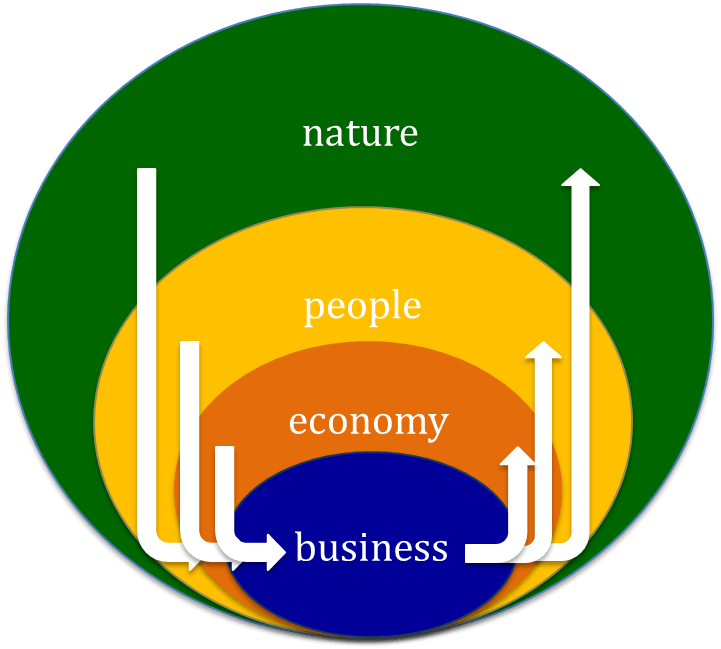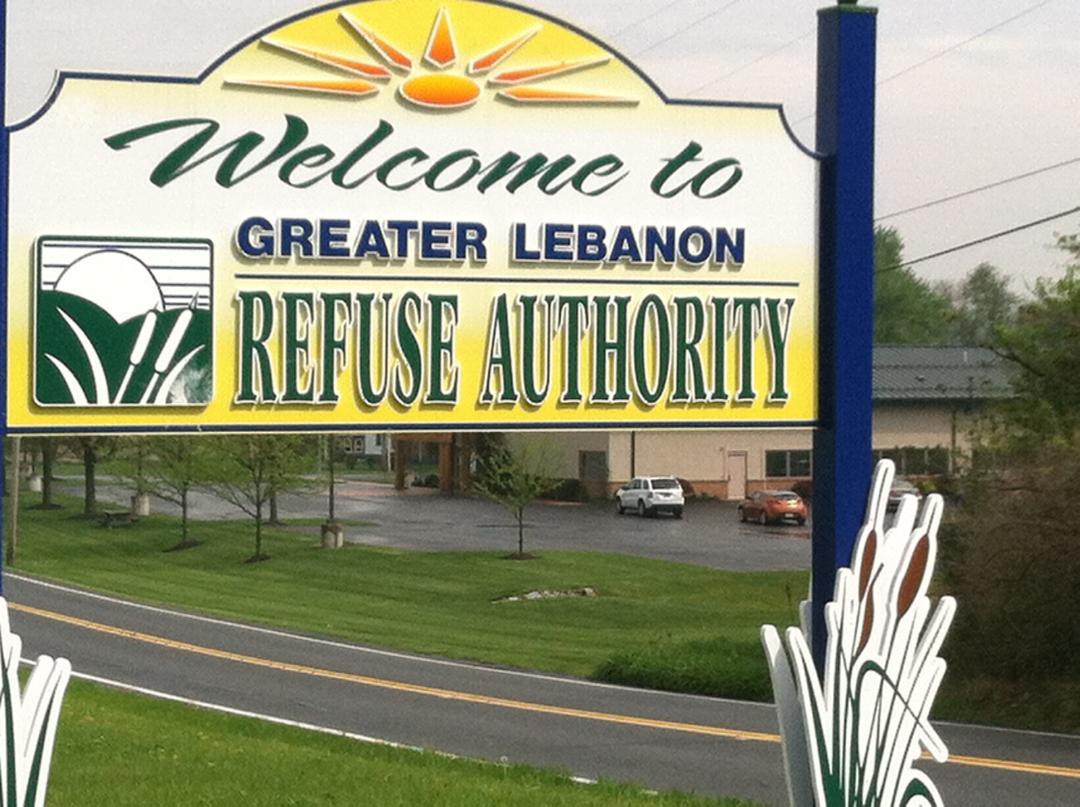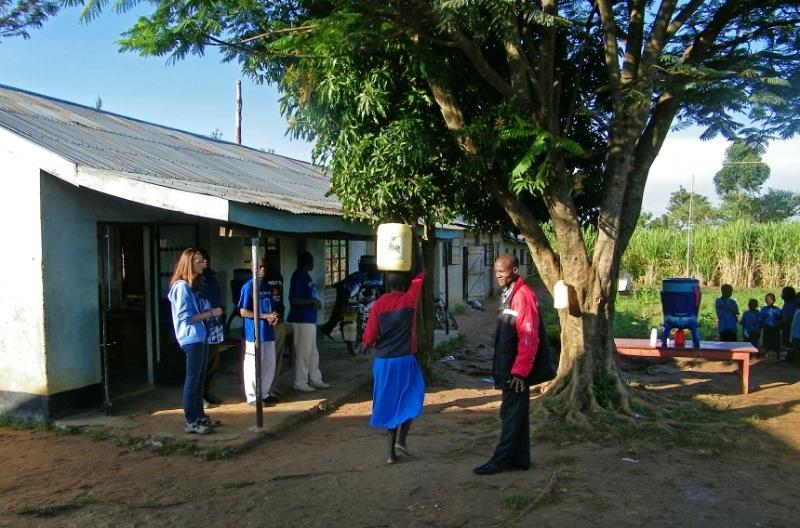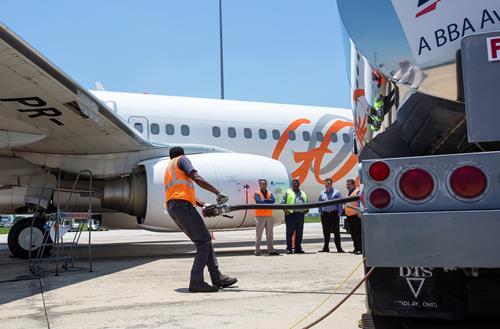The Quick & Dirty: Snake Oil Sellers


Shayna Samuels and Glenn Turner of Ripple Strategies wrote a great piece on the reasons why a social mission should be at the heart of your marketing. I've been lucky enough to work with the mother of cause and brand marketing, Carol Cone, since I landed in the U.S. many years ago - hi mom! And I am surrounded by people chipping away at companies to convince them to bring a social mission to their business and to bring it to life in creative ways. The missing social mission ... Having a social mission as a central part of who you are as a business has been at the front of what we've been trying to tell companies over here in the sustainability/CSR/purpose/shared value/citizenship/whatevergetsyougoing space.
The one essential thing so many companies miss completely when it comes to a social mission is that it isn't a choice but a given. You either have a social mission as part of your company identity or you are selling snake oil. Your choice.
Let's go back to the beginning of almost every company that exists today: You can find a clear social mission at the heart of why they started as a business. I'm not going to spend any time on the easy ones like TOMS or Tesla -- they are still young and new enough to remember, and their business model is still fresh enough as a reaction to a social need. But the same goes for those large companies that have been around for ages. Take a company like Tesco that was founded with a simple social purpose of getting affordable surplus groceries to the poorest communities as close to their homes as possible. AT&T can trace its roots back to the Bell Co., which wanted to help connect people -- sounds like Facebook today. BASF can trace its roots back to bringing light to the previously dark town of Mannheim. Cargill helped farmers store their grain in more effective ways through grain flat houses. Bank of America was founded to help new immigrants as most existing banks in America refused to provide them with basic services. And so the list goes on and on -- social mission at the heart of where most companies started.
And then so many lost their way.
Instead of being driven by the principles they were founded on they started listening to investors who knew nothing about mission and purpose. Profits became the new master instead of the mission that launched their success. Companies simply forgot about their roots. And like all good things, out of sight, out of mind. It would be a bit like the U.S. deciding that the ideas and principles that have guided them since the Founding Fathers should be dropped to simply make more money...
Companies are not only rudderless without this social mission - they are also disconnected from society. If they don't believe their success and existence is due to their social roots then there is not reason why the communities they serve should believe in them or support them. They have become nothing but snake oil sellers who believe in making money instead of their actual products or services. From serving the community to slaves of the mighty dollar. A money driven company is a meaningless company from the community and consumer perspective.
At the heart of growth lies a social mission.
And companies forget that and then asks: "Why can't I sell more stuff?" or "why don't people like me?" Because you forgot who you are.
But it is easy to fix -- if you really want to fix it. That's what we in sustainability do. We help you go find your roots. Your reason for being. We help you find your social mission and how it relates to the communities of today.
And to those who are new to the world like Facebook, Twitter, Apple, Tesla, TOMS, etc. -- we help you stay rooted in your social mission. We help you stay rooted to growth.
So please stop selling snake oil get back to your roots. We'll start liking you and might even start dating you again.
Image credit: Flickr/wfryer
A series of quick & dirty opinion pieces by Henk Campher. Senior Vice President, Business + Social Purpose and Managing Director of Sustainability at Edelman (www.edelman.com) out in the Wild West of San Francisco. Disrupter of purpose. Engineer of big ideas. Slayer of myths. Social media junkie – @angryafrican. He never wears ties. Ever. But always wears an accent with a strategy and opinion in his back pocket. Please note this series will not focus on individual companies and any reference is purely to provide color commentary. His new book, Creating a Sustainable Brand is available here.
Follow Henk Campher on Twitter.
The Growing Challenge of Water Procurement


By Graham Russell
Most sustainability professionals would agree that, in the long run, making adequate supplies of fresh water readily available to the world’s entire population is probably the most difficult resource-related challenge we face, especially in light of the weather uncertainties posed by global climate change. There is an essentially fixed amount of fresh water in the world, and for all practical purposes there are no substitutes for its role in keeping humans and animals alive -- not to mention growing the increasing amounts of food required for a growing global population.
Water is a strategically important issue for both developed and emerging countries. It is estimated that 780 million people around the world lack access to clean water for drinking, cooking and bathing. This results in millions of deaths a year from waterborne diseases, almost all in developing nations, and billions of dollars in healthcare costs.
In the developed world, the challenge is how to make clean water available in adequate quantities in the right place at the right time, a problem that has become known as the water/energy nexus: that intricate relationship between these two critical resources in which each needs the other in enormous quantities. It is estimated that nearly half of the water consumed in the U.S. is dedicated to cooling systems in thermoelectric power plants that produce electricity. In California nearly 20 percent of the state's electricity consumption goes toward water-related uses (purification, storage, transportation). In China, the South/North Diversion Project to bring water from southern rivers to the drier, more industrialized northern regions – a matter of national strategic economic interest – has resulted in one of the world’s largest engineering projects that is likely to cost over $100 billion when completed.
Superimposed on these global and national water challenges is the fact that nearly 70 percent of the world’s population will live in cities by 2050, compared with about 54 percent in 2014. Ensuring adequate supplies of water for both their residents and their industries therefore becomes a strategic competitive advantage issue for city managements. They will have to step up their water stewardship programs in the form of better forward planning to secure adequate supplies, improved maintenance of distribution systems to prevent leakage and main breaks, and pricing and incentive systems to encourage conservation and more efficient usage.
Also on the agenda for cities is the issue of too much water! Given the disruption to water supplies we have seen in recent years from increasingly intense storms and flooding, widely presumed to be related to global climate change, addressing water infrastructure resiliency will also be an increasing challenge for many large urban communities.
In the corporate world, we tend to think of water as a strategic issue for companies like Coca-Cola and Miller Coors, where water is a resource put into their products without which they have no business. Increasingly, however, leading-edge companies are employing innovative water stewardship programs not only to reduce operating costs, but also to enhance the equity value of their corporate brands. For example, water has been a key component of one global auto manufacturing company’s comprehensive sustainability initiative since 2000. By 2015 the company will have reduced the amount of water used across its global manufacturing base to produce each vehicle by 50 percent since 2000 -- saving hundreds of millions of dollars. Most global corporations that use water in large quantities now work closely with the communities in which they operate -- especially in water deficient regions -- to make sure they are addressing local concerns about water supply and wastewater disposal, thereby safeguarding their license to operate and enhancing their image as a good corporate citizen.
Across the globe, water is a vital strategic consideration for organizations ranging from national governments to city managements to diverse types of companies, large and small. At ISSP Conference 2014, these issues and more will be explored by a panel of global water experts moderated by Will Sarni, director and practice leader of enterprise water strategy, sustainability and climate change practice for Deloitte Consulting LLP. Other panelists are Susan Rokosz, senior environmental engineer at Ford Motor Co., and Paul Brown, director of applied research at the Patel College of Global Sustainability at the University of South Florida, and former executive vice president of CDM Smith, a global engineering and construction company.
Graham Russell is a regular writer for Triple Pundit and a member of ISSP’s Board of Directors. ISSP Conference 2014 will be held November 12-14 in Denver. For more information, visit http://www.sustainabilityprofessionals.org/
Creating Constructive Futures in Business and Beyond


By Giles Hutchins
Business strategist, Peter Senge, notes that our world today is shaped not by individuals alone but by networks of businesses and institutions, and that these organizations are grounded in an old logic which needs to radically shift for the times we now live in.
New horizons are created through new ways of thinking, perceiving and attending to ourselves, each other and wider life. It is up to the individuals within these organizations to co-create a new logic. This shift in logic is what Senge says is the biggest challenge facing organizational management and leadership today. Without this radical shift in thinking we will be unable to transform successfully towards a sustainable future; in other words, we will utterly fail in our evolution.
The logic of yesterday is of top-down, hierarchic, command-and-control, risk-adverse, competition-oriented, short-termed maximization, control-based thinking best suited to the Industrial Age. It is a mechanistic worldview based on reductionist logic that fragments reality into abstract definitions, silos and objects to be quantified, measured, controlled and then maximized, while largely overlooking the interrelated, fluid, connective, collaborative, participatory nature of nature.
In drawing inspiration from nature, we may step beyond our narrowed-down view of life and recognize the intrinsic patterns and reciprocal relations in our midst. These patterns can often seem confusing or complex for our reductionist minds, yet for our intuitive logic they are quite natural to cohere with – we are, after all, part of nature. Such patterns and flows are, by their nature, regenerative and sustainable. In applying this inherent logic of life, we no longer need to superficially bolt-on sustainability initiatives to unsustainable modus operandi. In going with the flow of nature, we redesign for resilience, ensuring sustainability – in all sense of the word – is ingrained in how we operate and innovate.
For Senge, creative orientation is what facilitates our shift beyond yesterday’s flawed logic. Creative orientation helps us address our many practical problems as opportunities for transformation, rather than risks to be mitigated or problems to be worked around. Real life challenges are what afford us the opportunities to transform to more resilient ways of operating. Through humility, openness and playfulness, creative orientation brings a radically different mindset beyond the hyper-competitive, quantized linearity of old. It is a ‘learning-through-doing’ approach to prototyping by collaborating amongst diverse stakeholders. Here, future outcomes are beyond pre-definition: It is the co-learning journey rather than the pre-defined destination that brings transformative value to the organization and wider ecosystem of partners involved; real benefits beyond ‘doing less bad.' This approach to business walks-its-own-talk by embracing a living, regenerative, empowering, co-creative, ecological way of being and doing which is aligned with our authentic human nature and deeper nature.
This fresh (yet ancient) logic enables us to see the richness and value of interrelated business ecosystems, of intra-organizational learning, of diverse stakeholder empowerment, of emergent leadership, of open co-innovation. Linear approaches to supplier and customer management are liberated into vibrant values-led ecosystems which nourish, and are nourished by, their own co-creativity. Company ‘IP’ transforms into ‘ecosystem intelligence’ beyond the old methods of privatised control. This may be mind-boggling for today’s minds’ still rooted in yesterday’s logic and it is a radical shift in management and leadership for all aspects of the business whether it be sales and marketing, human resources or supplier and customer management. All change please. And Senge is quick to point out that many organizations are already engaging in ways of behaviour in what he calls ‘life beyond the Bubble’ – life beyond the confining control-based bureaucracies of yesterday. It is what I call living beyond the illusion of separation, because it is an attitude that perceives beyond the self-limiting logic of egotism and individualism.
Intrapreneurs, internal network leaders and community builders across the business of all backgrounds (whether engineering, sales, logistics, etc.), will serve as the catalysts in empowering locally attuned teams of diverse stakeholders to make regenerative business a reality. Hence, the search for such catalysts within the organization as well as across the partner ecosystem, through new hires and external consultants is an important one. Often external consultants and specialist partners can help shine a light on areas of opportunity that people steeped in the cultural mind-set may need help in seeing. Business schools, activists, social innovators, think-tanks, consultants, change-makers can all help spawn such transformative creative orientations. Such networks will benefit from social media and collaboration technologies in helping co-innovate a bright future for business – the way nature intended.
Giles Hutchins applies 20 years business experience to a new business logic inspired by and in harmony with Nature. His latest book The Illusion of Separation is now out and you can watch a short video about it here.
Giles blogs at www.thenatureofbusiness.org, facebook community https://www.facebook.com/businessinspiredbynature and tweets @gileshutchins
SC Johnson comes clean over fragrance ingredients


American household giant SC Johnson is to expand its ingredient disclosure efforts by providing product-specific fragrance ingredient information.
Beginning early next year, consumers will have access to the main ingredients used to create the fragrances in SC Johnson products. It will begin with its air care products - including sprays, candles, oils and gels - initally in the US, Canada, followed by Europe. It will then extend the programme to other product categories. Consumers will be able to access this information on WhatsInsideSCJohnson.com or by calling the SC Johnson consumer product helpline.
SC Johnson has consistently been an industry leader in ingredient disclosure. In 2009, SC Johnson launched the site WhatsInsideSCJohnson.com to voluntarily disclose ingredients for the company’s lineup of air care and home cleaning products, each with a consumer-friendly list of ingredients.
In 2012, SC Johnson announced the release of its Exclusive Fragrance Palette to provide consumers with a comprehensive list of the fragrance ingredients found in the company’s products. In 2013, the company began adding pest control and other registered products to the site.
How Carbon Projects Can Bring Story to Your Sustainability Program


By Kathryn Sarkis, TerraPass
Balancing emissions with carbon offsets can do more than help your company take responsibility for its carbon footprint; it can also help build a stronger brand that has good story to tell. Carbon offsets come from a variety of different project types such as methane capture at landfills and agriculture operations, to transportation and forestry projects. Carefully choosing what emission reduction projects to support can create a story that reflects your company’s overall mission and vision and brings added value to the brand for both customers and management.
So how do you find the right emission reduction project to support? Regardless of the project type you need ensure that you are looking for a project that is of the highest quality. Carbon programs such as Verified Carbon Standard and Climate Action Reserve ensure that carbon credits are real, additional, and permanent by using accepted methodologies for validating projects. The programs' continuous monitoring ensures that a project performs as expected while registries track and clarify ownership to ensure no double counting. Once you are assured that you are looking at carbon credits that come from a verified, validated and tracked project the fun can begin.
The next criteria to look at when choosing a project are things like technology and location—and here’s where you can align your carbon offsets with your company’s mission or overall corporate social responsibility (CSR) goals. Every emission reduction project has both social and environmental co-benefits that can add to the story that your carbon offsetting tells.
Sustainability goals vary by company and from industry to industry, but there are a variety of projects and technology types to tell a great story. For example, many high tech companies place a premium on renewable energy. Renewable energy helps run data centers, which are responsible for the bulk of their emissions. A company like this might look for a project with technology that not only reduces greenhouse gases (ghgs), but also creates energy. Offsets that would help tell this story might include a wind farm or a biogas to energy project.
Likewise a company that has waste reductions as part of its mission might choose offsets from a landfill. By choosing a landfill a company can craft a powerful story around reducing waste and emissions. Since methane emissions from landfills are the 3rd largest anthropogenic source in the United States according to the EPA, it makes sense for companies to manage their own waste profiles first by reducing waste. Supporting this effort with a carbon offset from a landfill could amplify the impact of waste reduction efforts. Some key talking points, for instance, could include how the company is taking action first by reducing waste, then using carbon offsets to balance the rest.
Location can also be a powerful way to tell your company’s offset story. While climate change is a global issue, climate impact happens on a community level. Most offset projects have additional co-benefits that can be felt community-wide, and by choosing an offset project based on location a company can choose to support a specific area. Co-benefits to carbon mitigation can include reducing smell in the local area, reducing water pollution by reducing run-off and creating jobs in rural economies.
For example, the Greater Lebanon Refuse Authority (GLRA) is a project based in Lebanon, Pennsylvania, and is a popular TerraPass project. GLRA was an EPA Community Partner of the Year, and exemplifies how an emission reduction project can benefit its local community. TerraPass partner, MOM’s Organic Market, a grocery chain located in the Mid-Atlantic region, has purchased offsets from GLRA. GLRA’s proximity to MOM’s locations has allowed MOM’s to tell the story of not only reducing emissions locally, but also of the other benefits of the project. Additionally, the team was able to take a field trip to the landfill, engaging employees on another level, to see the project in action.
In addition to telling your sustainability story, choosing a specific project can also make explaining your goal of emission reductions easier as well. Carbon offsets can be difficult to explain, and it often takes some education before an audience fully grasps the concept of using offsets to mitigate emissions. Leveraging the project that your carbon offsets come from like a farm, in the case of agricultural methane offsets, or a community in the case of landfill methane offsets help create a picture in people’s minds that makes offsets more relevant. The carbon reductions go from a greenhouse gas reduction to a person or a community. TerraPass’ customer salesforce.com learned this first hand when they purchased carbon offsets from specific projects. According to Erin Decker, Senior Manager, Sustainability:
"To offset Salesforce.com’s carbon emissions from business travel we invest in projects that meet our rigorous standards. Being able to talk about the carbon offset projects using the actual project name, type and location helps make a subject that can feel intangible become real to our employees, and helps us reduce our overall impact on the environment."
Carbon offsets are more than an environmental tool to help your company meet its emission reduction goals. They are a powerful device to further sustainability goals and to tell an impactful story about sustainability, communities, and technology that help reduce the global warming potential of harmful greenhouse gases in ways that benefit people, planet, and profit. Projects can be more meaningful when they touch our lives, our goals, our communities.
To learn more about how your company can support a specific emission reduction project please contact Nancy Bsales at 973-743-5374
Kathryn Sarkis is a Marketing Manager at TerraPass. She has her MBA in Sustainable Management from the Presidio Graduate School. Follow her on twitter @KathrynSarkis
Follow the Liters Campaign Brings Water Filters to Rural Kenyan Schools


The Simakina Primary School is located on a remote dirt road that has been ravaged by the trucks that come to collect the sugar cane that grows in fields that surround the school for miles. The school has 520 students plus another 72 in early childhood development (ECD). Classrooms are crowded and spare. There is no electricity, though wires run from poles along the edge of the property. The children come from farm families, who mostly work in the cane fields, though some grow vegetables that they sell in market stalls in the nearby town. Most of them are barefoot, though a few wear plastic clogs.
There is a drilled well on the corner of the school property. The water has never been tested. A young girl lowers a plastic bucket on a rope into the water, then fills a jug which she carries on her head to one of six small buildings a hundred yards or more away.
We are there early. Kids mill around on the field. It somehow has the feel of summer camp. After introductions, Viola Adeke, the local area coordinator for Vestergaard explains in enthusiastic Swahili how the filters work. I can pick out the words maji safi, safe water. The teaching is done in a call-and-response manner, the children chanting the answers in unison. They already know the names of the diseases, in English: malaria, cholera, typhoid, bilharzia and they call them out as if reciting a nursery rhyme.
Viola demonstrates one of the seven units being donated, showing the brownish liquid obtained by back-washing the filter and comparing it with the clear water obtained from one of the four spigots that encircle the bright blue plastic device. "Which one is safe, she asks? The children all point at the clear one.
"Always use the clean, filtered water to drink. Also use it to wash your hands, brush your teeth and to wash fruits and vegetables with."
After the presentation, I spoke with a young girl named Melvin. She said she got sick with diarrhea and missed three days of school plus an additional day for a doctor's visit. She did not like this because it caused her to fall behind in her studies. She has a brother and a sister in school and both of them have lost time due to illness as well. She says that she feels safer now with a LifeStraw filter at home and another one at school.
Monday was the opening ceremony for Vestergaard's Follow the Liters campaign. It took place at the Ebombwa Primary School. A number of health and education officials were on hand. The students performed with dance and song and poetry, followed by a demonstration of the filters by the Vestegaard team. CEO Mikkel Vestergaard was on hand, along with his father, Torben, the former head of the company.
The filters were gratefully received by the head teacher who said that,"Water sanitation and hygiene are our biggest problems. Kenya is not on track to meet Millennium Development Goals with only 37 percent of schools having access to clean water. Absenteeism due to sickness is a major factor. We are going to increase our performance now."
The ceremony was the flowering. The seed was planted years ago and the tree has grown to a youthful strength. The fruit it will bear will be healthier children starting today. More than 1600 LifeStraw Community filters will be distributed by this program, each one providing clean water to 75-100 children for several years.
Western Kenya was selected because while water access is plentiful, water quality is poor, and water treatment is nearly non-existent. Government officials claim that municipal water treatment will arrive in ten years. When that is ultimately completed, a program like this will no longer be needed.
Images by RP Siegel
Editor's Note: Travel expenses for the author and Triple Pundit were provided by Vestergaard.
Not Your Grandparent's Workplace: What Makes Millennials Tick


Join TriplePundit, SAP and our special guests for a Twitter Chat about millennials and social entrepreneurship. Follow along at #SAPsocent on October 23 at 9 a.m. PST/Noon EST.
The global workplace is a changing dynamic these days, and no sector of the population knows this better than the millennial generation. Born at the tail end of the 20th century, a time best known for the advent of the clunky but versatile personal computer, the Walkman and equally hefty video cassette recorder, millennials have inherited a global workplace that belies a the personal me-ism of yesterday’s standards.
In fact, the workplace of today is increasingly more diverse, digitally adept and technically focused than ever before. And the 20 to 35 year-olds that are currently driving that innovation, says Nicolette Van Exel, SAP’s head of the Emerging Entrepreneur Initiative, know this high-paced arena is no longer their grandparent’s marketplace.
“[This] millennial generation grew up with access to information like never before,” said Van Exel. “It is a very, very conscious generation.”
The use of mobile devices like the cell phone, laptop and iPhone were really coming into prominence as this generation was heading off to school. By the time they were entering college, social innovations like Google, Facebook and LinkedIn were becoming a versatile part of school curricula. So for the millennials, technical innovation and social networking have an integral role not only in today’s marketplace but in the millennials’ vision of what really is important to their world. And as van Exel explained, that goes beyond the more rudimentary focus of the standard 9-to-5 job that dominated the economy in their grandparents’ age.
“This is the millennial generation that is super-entrepreneurial and is really focusing on making change that goes beyond just finding a job as a lawyer or becoming a doctor,” said van Exel. She said SAP has learned the value of harnessing that social focus in its own work with nonprofits and entrepreneurs, and has come to realize that matching that vision, just like matching those skills is good business sense for SAP. It’s also the future of a healthy global economy.
According to a study conducted in 2012 by leadership strategist Erica Dhawan, by 2025 75 percent of the global workforce will be made up of millennials. Van Exel said that SAP’s Emerging Entrepreneur Initiative takes that burgeoning workforce into consideration, and realizes that today’s social enterprises will play a significant part in the health of tomorrow’s economy. And being able to meet the talents of a community of workers that looks beyond what they earn will also be critical.
SAP uses several mechanisms to accomplish this. They make sure that their social enterprise projects, which pair nonprofits with emerging entrepreneurs address the needs of what are often niche sectors of the marketplace.
“I would say the most strategic and successful program today is the social sabbatical, which allows employees to go up to a month at a time to work with entrepreneurial nonprofits and also entrepreneurs from our emerging entrepreneur initiative,” said van Exel. The sabbatical “really builds not only a sense of community engagement, but … leadership skills.”
They also make sure that their hiring and training practices are in sync with the needs and functions of those programs.
“We align very strongly with our Human Resources group,” said van Exel. It takes into consideration that millennials have their own vision of career goals, and that may not include continuing in that same job if they feel they can’t align with the values of the company or job they work for.
“I think that millennials tend to jump from job to job quicker than we used to in the past. So I think retaining talent that you want in the company is a very, very important factor.”
Adam “Smiley” Poswolsky, author of The Quarter-Life Breakthrough, agrees with van Exel. A millennial himself, Poswolsky navigated the pitfalls of recessionary employment, only to realize that the high-paying, high-profile job wasn’t enough. It paid his bills, but like many millennials, he wanted more. He wanted to be happy.
“This is a generation that wants to align interest with purpose,” said Poswolsky, who notes that it’s also “a generation that thinks deeply” about what they want out of life.
After quitting his high-profile job at the Peace Corps in Washington DC, Poswolsky eventually landed in the San Francisco Bay Area. He is the director of the Bold Academy and facilitator of the Hive Global Leaders Program, as well as a StartingBloc fellow who mentors other up-and-coming entrepreneurs.
One of his key pieces of advice to millennials who read his book is “Accept that there probably isn’t only one answer, and explore multiple answers.” That’s a radical shift from the advice of grandparents who counseled the sage idea to get a good job and once you get it, keep it.
Businesses that want to retain good talent said van Exel, have to also think just as deeply about what they can offer to a generation of workers that are looking for values and social impact. She says the corporate social responsibility element that is built into SAP’s business model speaks to millennials – both within its ranks of technical professionals and beyond, in the entrepreneurial setting.
“You really have to have a very, very compelling proposition for people coming into the workforce and especially in the technology sectors.” said van Exel.
Poswolsky agrees. Millennials want to work for “companies that have really thought about their values.” They also expect more from the work place and employers that realize that with today’s technology, there’s often more than one way to get the job done, including telecommuting that allow for personal life goals.
“So many jobs can be done [at home]” said Poswolsky, who challenges the notion that people need the strictures of an office job and set hours to get the work done. “They are going to work harder for you,” if they are happy.
And they are going to stay longer and remain engaged if they find that their values are appreciated and given an outlet for expression, said van Exel.
One of SAP’s accomplishments, said van Exel, is proving that these values can work pretty much anywhere in the world. Van Exel works with a team that interfaces with nonprofits and emerging entrepreneurs in developing economies like Brazil and India, where social programs that further education, or ensure there’s running water in a community, are often needed. Social enterprises are the glue that brings together the entrepreneurs and the nonprofits, and help both succeed.
But understanding the lay of the land in each economy is critical to the success of the partnership, said van Exel.
“[In] Brazil we found a very ready kind of infrastructure and entrepreneurial culture that we could easily engage with. It was very easy to recognize and mobilize.” That’s because there were already connections established in the private sector that helped incentivize the partnership and made it easier to engage with nonprofits.
“When you look at India, it is a slightly more complex market.” The size of the country and other commercial dynamics meant it took more on-the-ground work. But in both countries, as well as Kenya, where SAP is about to launch its first social enterprise program in Africa, the same opportunities for success existed.
“When you look at the similarities we find in those economies [you see] that there is a real opportunity to build a good partner ecosystem,” said van Exel. Having consideration for cultural differences and priorities are part of what drives that success as well.
Social enterprise is a critical part of this emerging global economy, and the millennial workforce and new values about what makes a job and a career are part of the dialogue that millennials are pushing. In doing so, they are also helping to remake the way we approach the world and the values that shape our future.
Image credit: Itupictures
20 Years Later, a Generation of Rwandans Inspires the World


Editor's Note: This is part two in an ongoing series on Rwanda's progress. Click here for part one, or follow the series here.
Twenty years ago, Rwanda was the site of what has been called the most hellish 100 days of the 20th century. Today, it is a place of pervasive progress and limitless promise. Visit the shopping malls amidst Kigali’s rapidly maturing skyline, or test the farthest reaches of its country-wide fiberoptic connectivity. Once brushed aside for its seemingly delusional aspirations to become East Africa’s Singapore or Silicon Valley, Rwanda’s message is now loud and clear. Rwanda is serious about its perhaps-no-longer-so-lofty dreams.
But, is it really safe? This is still the most common question I hear from foreigners, not only from the Global West, but from neighboring East Africans as well. Having lived in several major U.S. cities, including Los Angeles, Washington, D.C. and now San Francisco, I’m not sure I’ve had a safer home than the friendly hillside neighborhoods of Kigali, Rwanda. But don’t take my word for it – ask Rwandans: A 2012 Gallup poll indicates that Rwanda’s citizens feel safer than citizens of any other country in Africa. The same poll ranks Rwanda second globally in percentage (89 percent) of women who feel safe walking alone at night.
Today, Rwanda is arguably the most peaceful, cleanest and least corrupt country in Africa -- not to mention one of the fastest-growing economies in the world. Note that this is not just another short-lived and superficial demonstration propped up by the notoriously dysfunctional foreign aid machine. Rwanda has adamantly refused to follow in the ruinous path of its African neighbors. Instead, the country has developed much more organically. Pundits can say what they like about President Paul Kagame, but it’s foolish to argue the success of his rogue philosophy of national development by self-reliance.
Perhaps news of Rwanda’s recent progress is not new to you, but have you pondered its full significance within the context of its tragic past?
Consider the generation responsible for much of this unthinkable turnaround. Perhaps then you might begin to grasp why there is no greater success story over the past 20 years.
Haunted by the most horrific of memories and deprived by and large of parents and mentors -- many of whom perished or relocated during the violence -- this generation has taken on the most formidable of challenges and emerged victorious. At last, Rwanda’s youth is turning heads around the world.
Take Adrien Niyonshuti, the centerpiece of Rwanda’s first national bike team and the award-winning documentary, “Rising from the Ashes,” who made history by representing Rwanda in the 2012 Olympics. Or Rwanda’s thriving community of young artists – ranging from world-renowned musicians like Cornille Nyungura to fine art studios like Uburanga, Ivuka and Imena, whose peace-promoting paintings and sculptures are quickly rising in popularity across the world.
Edwin Sabuhoro, founder of Rwanda Eco-Tours, won the IUCN’s 2008 Young Conservationist Award for his work to transform poachers of the endangered mountain gorilla into tourism guides.
And I’d be remiss without mentioning legendary entrepreneurs like Sina Gerard and Serge Ndukwe, who have made good on their dreams to provide jobs for thousands of Rwandans by producing some of the country’s most popular and delicious packaged food products.
These national heroes all have something in common: They understand what can happen when a nation and its people are divided. They believe in the importance for all Rwandans to share in a brighter, more prosperous future. “More than personal fame or fortune, we thirst to see our country succeed,” says Jean Bosco Bakunzi, the 28-year-old founder of Uburanga Art Studio.
Adrian desires to win races for his country. Bakunzi and his fellow artists use the beauty of art as a source of healing for their neighbors, orphaned children and people across the world. Edwin fights tirelessly to preserve his country’s wildlife while caring for Rwanda’s rural villages. Sina and Serge create economic opportunity for their country while paving the way for the next generation of aspiring entrepreneurs. This generation of young heroes has evolved into the role models this country has lacked in fathers, mentors and teachers.
These stories hint at one of the most glaring, if for now softly measured, indicators and drivers of progress – the degree to which achievement, and economic success in particular, are intentionally aligned with commitment to positive social and environmental impact. This generation’s people and country-first philosophy has established a culture which is propelling Rwanda’s emergence into a hotbed of responsible business and social enterprise.
Next week’s article will examine several elements of Rwanda’s cultural identity that have helped to fuel this emergence.
Image credits: 1) Uburanga Art Studio 2) Rising from Ashes
Walmart Commits to More Sustainable Food. Is it Serious?


On Monday, Walmart held its second semi-annual Global Sustainability Milestone Meeting -- webcast live and re-aired the following day -- and announced a new pledge to help create a more sustainable food system. Taken at face value, the country’s largest food retailer appears to be making a real commitment to help develop a healthier, more affordable, and less environmentally damaging food supply. Walmart’s real legacy in this area, though, will be measured by how much concrete action follows its ambitious commitments.
At the outset of the milestones webcast, the company’s CEO, Doug McMillon, proclaimed that in order to meet the population’s increasing food demands, Walmart and its suppliers need to become more sustainable players in the global food supply chain. According to this new commitment, Walmart will aim to achieve this by ensuring that the food it sells, and the supply chain from which that food comes, is: (i) more affordable (to the environment, society, and customers); (ii) safer and more transparent; (iii) healthier; and (iv) more accessible.
Like many corporate marketing efforts, in both the webcast and the company’s concurrent announcements it is difficult to parse the genuine commitments from the hollow promises; the real passion from the empty rhetoric meant to patronize the most environmentally conscious consumers and NGOs.
To look strictly at its pledges, Walmart sure seems to acknowledge that bold action is required if it is to contribute to reversing the trends of environmental degradation and resource scarcity. The company, which claims that environmental sustainability is now an “essential ingredient” in its business model, already says that it strives to sell only products that “sustain people and the environment.”
So, how exactly is the company planning to increase the sustainability of the food it buys and sells?
Walmart’s pillars of food sustainability
Affordability. First and foremost is Walmart’s pledge to reduce the “true cost” -- i.e., the cost to consumers, society, and the environment -- of the food it sells over the next decade, by targeting reductions in greenhouse gas (GHG) emissions and water usage; increasing food yields; and promoting the adoption of efficient and sustainable agricultural practices.How, exactly, will Walmart do these things? For one, the company touts its responsible sourcing practices, and at the milestone meeting Walmart announced a commitment to sustainably source at least 50 percent of the palm oil used in its private brands in Brazil and 100 percent of beef consumed there over the course of the next year. Responsible sourcing is also something the company spills a good amount of ink on in its 2014 Global Responsibility Report (CSR report).
Importantly, in 2010 Walmart pledged to eliminate 20 million metric tons of GHG from its supply chain by end of 2015, and though the company stood behind that commitment on Monday, its latest CSR report announced that it had thus far eliminated just 7.55 million metric tons of GHG and hoped to get that figure to 18 million metric tons by the end of next year.
Moreover, though Walmart has become more energy efficient over the last decade, its absolute GHG emissions are rising as the company continues to expand. As others have noted, there are inherent, unresolved tensions between Walmart’s business model -- adding massive stores surrounded by massive parking lots -- and its aspirations for sustainability.
Safety and Transparency. Walmart also committed to selling “safer” food (i.e., food that isn’t contaminated) and providing more information about the products it sells. For instance, it promised to increase food testing in China and to continue its practice of unannounced third party audits at suppliers. On the subject of transparency, Walmart plans to install video monitoring systems on the farms that provide Walmart’s pork (as a way to improve animal welfare in the supply chain), and to continue to focus on product traceability in meat and seafood.
Health. Walmart and its foundation also aim to “make healthy eating easier” by providing nutrition education to 4 million U.S. households, starting in 2015. In addition, the company is phasing out the unhealthier ingredients in its own food; its web announcement notes that Walmart has thus far reduced sodium in its brands by more than 13 percent, and sugar by more than 10 percent. The company’s 2014 CSR report also indicated that Walmart has targeted “food deserts” for new store locations, something that conveniently helps the bottom line and gives people greater access to cheap food and other goods.
Accessibility. Finally, Walmart hopes to increase access to its food products by providing 4 billion “healthier meals” to those in need over the next five years. On its website, the company boasts that it has already donated more than 1.5 billion pounds of food since 2010, and at the milestone meeting, Walmart announced that it had already exceeded its 2010 goal of giving $2 billion in cash and in-kind donations to fight hunger by 2015, having given more than $2.6 billion to date. Perhaps more than in any of the other pillars, it appears that Walmart is making real and significant progress toward fighting hunger.
The importance of real action
As the Times pointed out, "Walmart’s food policies and practices have a tremendous impact given its size,” so if -- and this is a big “if” -- there is real action in support of the lofty promises, Walmart and its supply chain could go a long way toward changing food policy in this country, particularly as it relates to climate change.
In some cases, like Walmart’s efforts to combat hunger, it appears that the company is taking measurable steps to meet -- or even exceed -- its goals. Yet, in other places, the company is conspicuously light on the details, and we may have good reason to be suspicious. In the past, Walmart’s “splashy” sustainability commitments have tended to be much more style than substance and have attracted accusations of "green washing."
Regardless of whether or not Walmart meets its goals and follows through on its myriad pledges, however, the mere fact of the company’s stated focus on sustainability could send a strong message to Big Food.
Moreover, thanks in part to a recent campaign by OxFam, Walmart’s announcement is just the latest in a series of commitments by major food production companies -- many of which, such as Cargill, General Mills, and Kellog, are a part of Walmart’s supply chain -- to focus more on sustainability.
A few months ago, for example, General Mills explicitly acknowledged the dangers of climate change and that “Business, together with governments, NGOs and individuals, needs to act to reduce the human impact on climate change.” Within “key ingredient supply chains,” General Mills will now require suppliers to “demonstrate improvements in material environmental, social, and economic outcomes.” The company also committed to achieve “zero net deforestation in high-risk supply chains by 2020."
Like Walmart, the size and power of General Mills means that its pledges should incentivize producers to reduce their environmental impact, who may, in turn, encourage farmers to improve their own practices.
Hopefully, the promises of Walmart, General Mills, and others will amount to real change and a shift in the way Big Food does business. Time will tell.
Image credit: Flickr/jeepersmedia
Sugar in Brazilian Skies: Is Farnesane the Fuel of Airlines’ Future?


The commercial aviation industry has long been unstable and struggled to make a profit, in part because of the volatility of fuel prices. Consolidation and cost-cutting have improved many airlines’ financial performance in recent years, but they are only one epidemic, fiscal crisis or political time bomb from reeling. That is one reason why for several years, many airlines have experimented with adding biofuels to conventional jet fuel in order to harness energy security—and try to reduce those pesky carbon emissions that are difficult for the airline industry to avoid. Now Gol, the second largest airline in Brazil, is testing farnesane, a clear fuel sourced from sugar cane.
The partnership between Gol, Amyris, a California-based biofuels company, and the French energy giant Total culminated in a flight earlier this summer between Orlando and São Paulo, which was powered by conventional jet fuel blended with 10 percent farnesane. For now Gol has commited to using the 10 percent blend on select international flights between the U.S. and Brazil. Then last month a Lufthansa flight between Frankfurt and Berlin was also powered in part by farnesane.
These flights join the many experiments led by airlines including Southwest, KLM, British Airways and United. The airlines say they are committed to reduce carbon emissions by 50 percent by 2050, but the road ahead is long and full of uncertainty. Cost, scale and the food-vs-fuel debate are among the roadblocks in the way of more sustainable jet fuel production. So what is different about this sugarcane-based fuel?
Part of the answer lies in Brazil’s long history, and relative success, with its sugarcane ethanol program. Ethanol has been used to fuel automobiles in Brazil since before World War II, and after its post-war decline, accelerated again in use during the 1970s as a result of the global oil price shocks. Like other fuels, sugarcane ethanol has been subjected to its share of price and supply volatility, but the numbers speak for themselves: as much as 94 percent of the cars in Brazil include flex-fuel tanks. Even the gasoline tanks in cars are filled in part with ethanol: depending on supplies, gasoline in Brazil by law includes a blend of 20 to 25 percent ethanol.
Add Brazil’s distribution network, sugarcane production and biofuel infrastructure, and there is a chance cane-based ethanol could be the key towards cleaner aviation fuel. Amyris is certainly bullish, claiming its farnesane product reduces particulate matter three percent and its performance is overall 70 percent more efficient than other renewable fuels. Proponents of sugarcane ethanol also insist it is also 30 percent more efficient in land use, which would tamper the ongoing fears over the fuel-vs.-food debate. This could change if cellulosic ethanol from switchgrass, algae, agricultural waste or jatropha becomes reality; but while those options are now technically possible, they are still far too expensive to be considered by the aviation industry.
And it is cost that is still a barrier to farnesane, or any biofuel product, from taking hold in the industry. Amyris told the New York Times its product will be cost-competitive in the next few years; but this is the standard response of all biofuel companies. Structural challenges remain as well. Even though the U.S. nixed the tariff on Brazilian sugarcane ethanol almost three years ago, corn ethanol production is still a favored program of U.S. policy makers. Agricultural commodities are also sensitive to price volatility, so if sugar prices every soar, that would scare off the aviation industry. Nonetheless, sugarcane biofuels, with their proven track record, are one of the more promising clean energy options the aviation industry has seen so far.
Image credit: Amyris
After a year in the Middle East and Latin America, Leon Kaye is based in California again. Follow him on Instagram and Twitter. Other thoughts of his are on his site, greengopost.com.